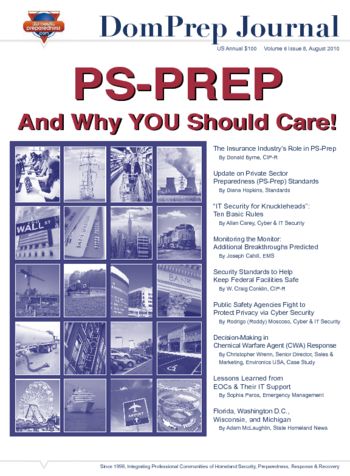
'IT Security for Knuckleheads': Ten Basic Steps
Allan Carey
August 25, 2010
The still misunderstood, and sometimes even frightening, term “Cyber Security” has entered the common vocabulary in force in recent years. It is generally agreed that the lack of cyber security is dangerous, and potentially catastrophic. But there are a number of common-sense guidelines to follow to protect an organization’s, or company’s, cyber security systems and files. Here are ten of them to start with.

Review of Medical Countermeasures and a New Federal Approach
Martin D. Masiuk
August 25, 2010
HHS Secretary Kathleen Sebelius announces the allocation of $1.9 billion for new U.S. medical
countermeasure capabilities – plus five “breakthrough” initiatives to get the ship underway and on a
course both straight and true.

The Insurance Industry's Role in PS-Prep
Donald Byrne
August 18, 2010
The much-revered U.S. “private citizen” has become increasingly critical of all levels of government in recent years, according to most recent polls and surveys. And justifiably so, according to a virtual army of pundits and commentators – and many politicians themselves. But that same beloved private citizen, if he or she is honest, could quickly find another person to blame simply by looking atThe Insurance Industry’s Role in PS-Prep the culprit in the mirror each and every morning.

Public Safety Agencies Fight to Protect Privacy via Cyber Security
Rodrigo (Roddy) Moscoso
August 18, 2010
The numerous technological advances in security systems in recent years have created new opportunities for growth, for improved operational capabilities, and for both legal and moral complications. Question: What is the dividing line between improved security and personal privacy – or is there one?

Decision-Making in Chemical Warfare Agent (CWA) Response
Christopher Wrenn
August 18, 2010
This is the first of a four-part series on Chemical Detection and Decontamination for Multiple Applications. In response to releases of CWA, there may not be one technology or one “answer” that is correct. The responder must take into account all of the clues to determine the presence or absence of CWAs in order to take appropriate action.

Update on Private Sector Preparedness (PS-Prep) Standards
Diana Hopkins
August 11, 2010
The 11 September 2001 terrorist attacks against the WTC Towers & the Pentagon theoretically “galvanized the nation” – but it still took roughly three years before the 9/11 Commission recommended the development and promulgation of “private-sector preparedness standards.” Another six years have passed, and three of those standards are ready (almost) for review, certification, and publication in their final form. Why did it take so long?

Lessons Learned from EOCs & Their IT Support
Sophia Paros
August 11, 2010
The 2009 inauguration of U.S. President Barack Obama, the nation’s first African-American commander in chief, was the biggest – and, of course, best publicized – national “special event” on the long and growing list of emergency-management best-case/worst-case scenarios. Fortunately, most of the lessons learned two years ago involved relatively minor errors and omissions.

Web Users Increasingly Rely on Social Media to Seek Help in a Disaster
Domestic Preparedness
August 11, 2010
A new American Red Cross survey shows 74 percent of web users turn to social media to seek help for themselves or others during emergencies – and they expect first

Security Standards to Help Keep Federal Facilities Safe
W. Craig Conklin
August 4, 2010
Two major new DHS (Department of Homeland Security) publications are now available to help federal officials throughout the country tighten the physical security of the office buildings, warehouses, and – literally – hundreds of thousands of other taxpayer-funded federal facilities entrusted to their care.

Monitoring the Monitor: Additional Breakthroughs Predicted
Joseph Cahill
August 4, 2010
More and better clot busters, instant timelines, smarter (maybe even genius level) cellular technology, and open-source software. All are part of the still ongoing revolution in medical monitoring devices that started with the EKG and defibrillator and has already saved untold thousands of lives in almost every country in the world.






